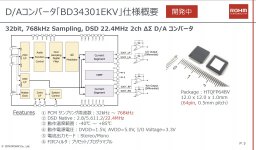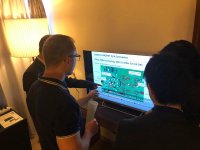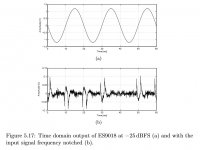Another tweak to try is biasing your I-V opamps into class A.
That is what I did.
Thing is, I suspect the hump more likely comes from the differential summing stage and adjusting I/V output offset just gets rid of the common mode input offset of the differential summing stage. That is only a guess, of course. Would have to do some tests and measurements to find out with any certainty.
One possibly interesting way to find out might be to operate the differential summing stage on separate power supplies that are offset by AVCC/2. Say, around +16v, -14v or something like that. The opamp can only know there is a common mode offset relative to its power supply terminals, after all. It isn't one of those opamps with a ground pin.
One reason to suspect the opamps more than the dac chip is because it was said over at ASR that the hump could never be removed if using AD797. Only OPA1612 is known to work for sure. So, if in the opamps, differential summing exercises an opamp in more regimes than I/V conversion does. At least some of the errors in the I/V are mostly or fully limited to DC errors which apparently can largely be ignored.
Last edited:
That is what I did.
Biasing Opamp OP into class A has nothing to do with AVCC/2 offset.
It implies loading the OP with a CCS to either rail, thereby shutting off one
OP device (P or N) and having the other never shutting off provided
the CCS has sufficient current. It will not affect the OP offset at all.
I think it makes less difference with the newer generation opamps but
can still make things sound slightly 'warmer' 'less digital'
Thing is, I suspect the hump more likely comes from the differential summing stage and adjusting I/V output offset just gets rid of the common mode input offset of the differential summing stage. That is only a guess, of course. Would have to do some tests and measurements to find out with any certainty.
WRT OP 'summing stage' yes it has a lot of jobs to do. One little known
tweak that we used to do, and it wasn't my idea, was balance impedances,
both R and C, looking out of each opamp IP terminal. You take the OP as
ground. So, for example, a 100pF cap from OP to - IP would be balanced
with a 100pF cap from + IP to gnd. Same for R's This cancels common
mode distortion. Problem is, the 'summing' opamp already has this in effect.
I think I have stated before, it might be worth hand matching all the R's and
C's on the OP opamp. It may bring rewards, hard to say. Doing the matching
of impedances as above definitely made a sonic improvement.
Have you tried bulk foil resistors? Thee are definitely worth evaluating but
pretty expensive. The filter caps are also important. It's worth comparing
FKP (FF Polyprop) with polystyrene film. Polystyrene can sound better
for some apps
Yeah, that's not a bad idea, trying unequal + and - supplies. You neverOne possibly interesting way to find out might be to operate the differential summing stage on separate power supplies that are offset by AVCC/2.
know till you try it.
+1Say, around +16v, -14v or something like that. The opamp can only know there is a common mode offset relative to its power supply terminals, after all. It isn't one of those opamps with a ground pin.
I'm a little skeptical WRT ASR at times, regardless, the AD797 is a VERY tricky opamp to get the best out.One reason to suspect the opamps more than the dac chip is because it was said over at ASR that the hump could never be removed if using AD797.
I think OPA1612 is probably better sounding.Only OPA1612 is known to work for sure. So, if in the opamps, differential summing exercises an opamp in more regimes than I/V conversion does. At least some of the errors in the I/V are mostly or fully limited to DC errors which apparently can largely be ignored.
Biasing Opamp OP into class A has nothing to do with AVCC/2 offset.
It does if we are talking about the I/V opamp.
It implies loading the OP with a CCS to either rail, thereby shutting off one
OP device (P or N) and having the other never shutting off provided
the CCS has sufficient current.
Sure, for the differential summing stage.
I'm a little skeptical WRT ASR...
Agreed, and for multiple reasons. The AP is the main attraction, it can probably be trusted for accuracy if operated properly. On the humans that seem to dominate the place...well, that's another matter.
Could be AK4499 may not stay on top of the heap very long. Rohm is working on a dac that some suspect might be better for DSD. Looks like we will have to wait some to find out.
According to this page, the specs are:
SNR =131.6dB, THD+N= -115dB.
I think the AK4499EQ has some headroom still:
SNR =140dB, THD+N= -124dB.
According to this page, the specs are:
SNR =131.6dB, THD+N= -115dB.
I think the AK4499EQ has some headroom still:
SNR =140dB, THD+N= -124dB.
Its the 'native DSD' thing that bypasses the SD modulator in the block diagram. Getting -115dB THD+N might sound pretty good in that case. AK4499 has to re-modulate DSD which may adversely affect SQ in a way that does not show up in measurements as crude and mostly-useless as THD+N.
Its the 'native DSD' thing that bypasses the SD modulator in the block diagram. Getting -115dB THD+N might sound pretty good in that case. AK4499 has to re-modulate DSD which may adversely affect SQ in a way that does not show up in measurements as crude and mostly-useless as THD+N.
Fair enough! Well, we'll have to try that for a v2...
Could be AK4499 may not stay on top of the heap very long. Rohm is working on a dac that some suspect might be better for DSD. Looks like we will have to wait some to find out.
Thanks for that Mark.
I had noticed it mentioned (somewhere) that the TI patent for advanced
segment DAC would have expired recently so was wondering if that may
impact any new development. Any DAC wiith true CCS OP, I'm interested in.
Is there any other info for this Rohm DAC?
cheers
T
Terry,
You are welcome
There is some more at the following pages, but I had to use the Chrome translate function to read it:
????????????????????????? (1/2) - EE Times Japan
????????????????????????? (2/2) - EE Times Japan
cheers
Mark
You are welcome
There is some more at the following pages, but I had to use the Chrome translate function to read it:
????????????????????????? (1/2) - EE Times Japan
????????????????????????? (2/2) - EE Times Japan
cheers
Mark
Last edited:
Thanks for that Mark.
I had noticed it mentioned (somewhere) that the TI patent for advanced
segment DAC would have expired recently so was wondering if that may
impact any new development. Any DAC wiith true CCS OP, I'm interested in.
Is there any other info for this Rohm DAC?
cheers
T
What I found is this press release with a picture of the evaluation board and a link to this marketing landing page. On that page, there is a link to the BD37201NUX, which is an interesting LDO designed specifically for audio. The numbers aren't as good as the LT3042/LT3045, but it might be worth a look anyway.
... an interesting LDO designed specifically for audio. The numbers aren't as good as the LT3042/LT3045, but it might be worth a look anyway.
Right, I saw that too. Thing is one would have to buy or build an evaluation board for it and see how it sounds when used to power various audio circuits. It would be a diversion at this point for us to do that, but possibly an interesting one.
...I think the only possible advantage could be transient response...
Maybe. Not sure if we might be missing something when it comes to regulators for very-sensitive, zero-PSRR, ultra-low distortion audio circuits/devices. Than again, maybe not.
Last year in Munich i listen to Rohm top Dac BD37806TL 32bit,768khz,DSD 22,4mhz D/A converter and talked to their research team. Dac is curent type...they were proud at their Dac power supply regulators and opamp regulators...but i can*t say how are they.
http://60.43.147.145/bekkan2019/NewDevice/NewDevice.html
Strange that nothing more was talking about that dac...
http://60.43.147.145/bekkan2019/NewDevice/NewDevice.html
Strange that nothing more was talking about that dac...
Attachments
Agreed, and for multiple reasons. The AP is the main attraction, it can probably be trusted for accuracy if operated properly. On the humans that seem to dominate the place...well, that's another matter.
Mark, Terry have you ever seen this type of plot? I read about the "ESS hump" etc. and no measurements show much, but this is clearly some pathological behavior in the DAC. I don't know if this was ever published and it was sent to me in confidence, but the folks that did this are very competent and I trust their results. If this is old news (and it might be) no harm done, I don't follow the DAC stuff much.
Attachments
Mark, Terry have you ever seen this type of plot? I read about the "ESS hump" etc.
Haven't see that particular plot, but the impression I get regarding 'hump' removal looks like it could be related to the opamp ouput stage more than dac: ESS THD ‘Hump’ Investigation | Page 14 | Audio Science Review (ASR) Forum
Anything you might be willing to say about that?
Anything you might be willing to say about that?
Yes, that plot was probably done with a single ended output. So let's postulate that those zero crossing glitches have an anti-symmetry with the desired signal so a perfect differential output cancels the "badness". It is possible that all this tweaking is doing is trying to achieve this perfect cancellation. You will notice the artifacts are rich in harmonics. If that is the case the comments related to getting excellent match in all the components of the circuit are right on. IMO worth exploring.
EDIT - That old conversation on ASR is about the ESS9018 so the graph I posted applies.
Last edited:
hifibunny3 drivers
Hello all!
I'm very satisfied with es9038q2m hifibunny drivers performance.
Using the DAC board with Volumio starting to make troubles because Volumio is dropping/disconnecting/no web interface random.
I have tried to compile hifibunny on latest version of Volumio, MoodeAudio and Rune according VinnyLorrin directions, but without success.
Any one succeeded?
Hello all!
I'm very satisfied with es9038q2m hifibunny drivers performance.
Using the DAC board with Volumio starting to make troubles because Volumio is dropping/disconnecting/no web interface random.
I have tried to compile hifibunny on latest version of Volumio, MoodeAudio and Rune according VinnyLorrin directions, but without success.
Any one succeeded?
I'm very satisfied with es9038q2m hifibunny drivers performance.
Hi makobd,
Not sure if we are clear on what you are using with hifibunny driver:
Are you using the ES9038Q2M board from this thread?
Are you using the hifibunny controller board and firmware?
- Home
- Source & Line
- Digital Line Level
- ES9038Q2M Board


